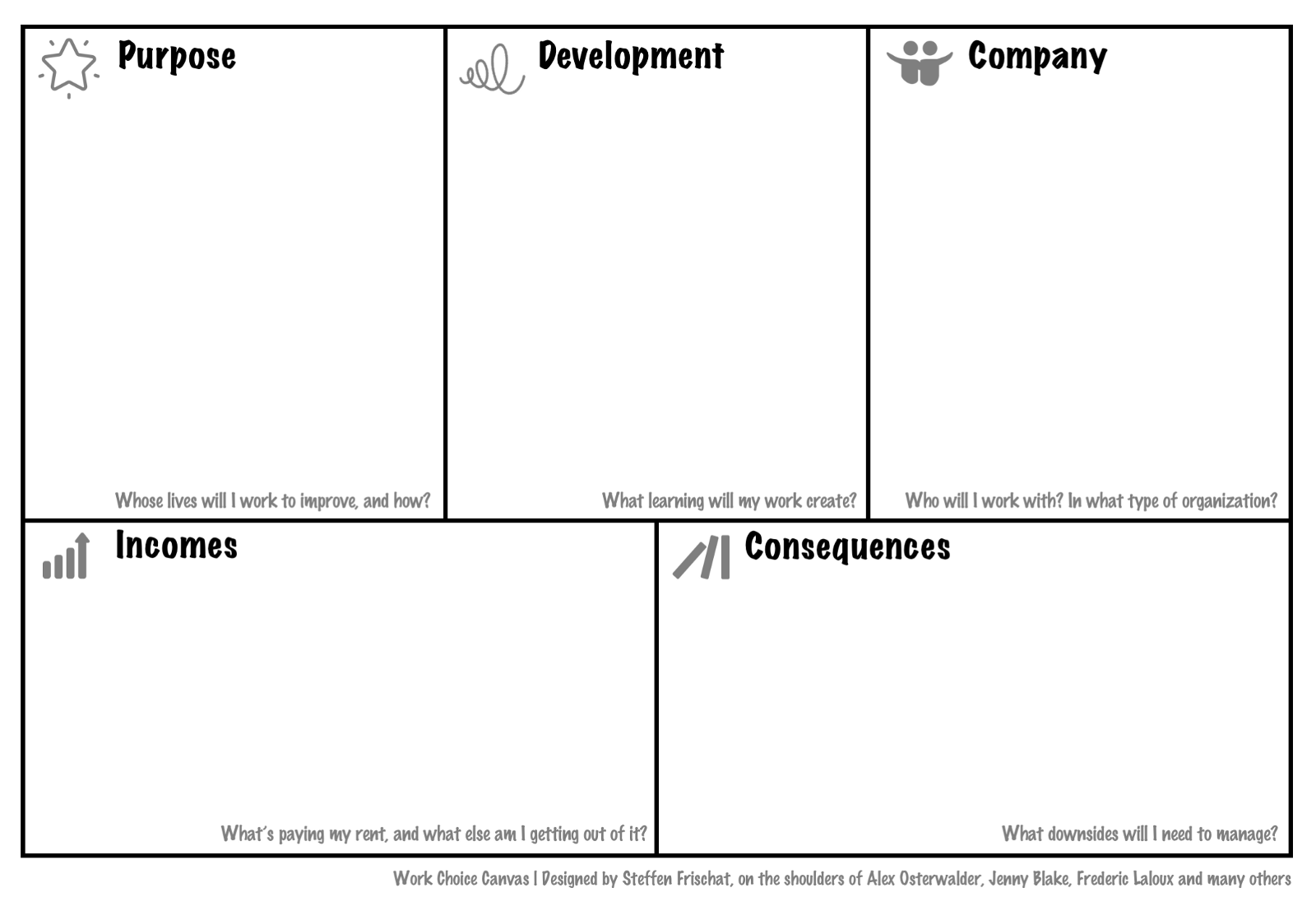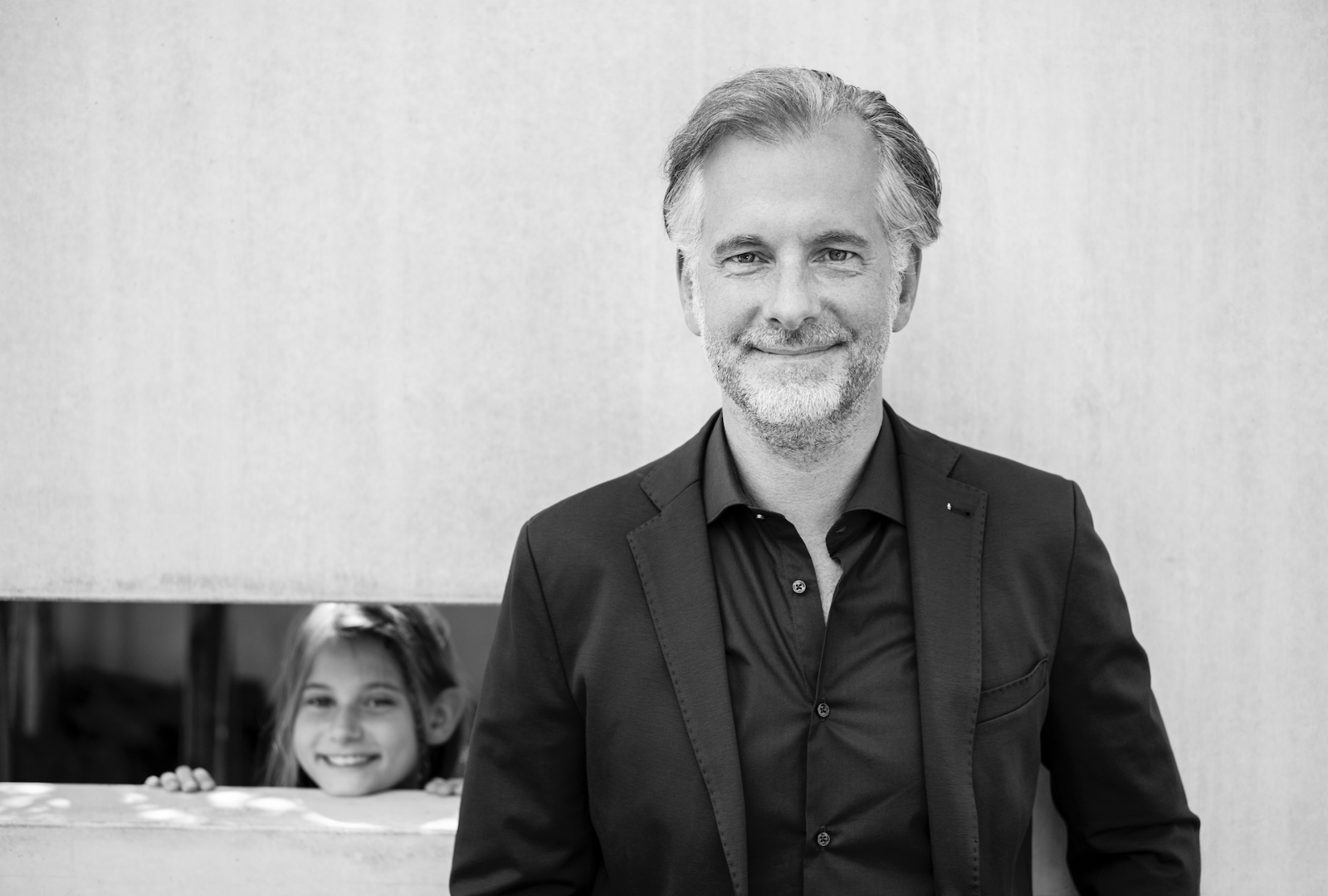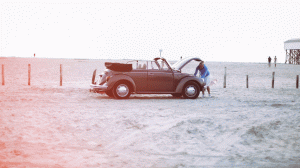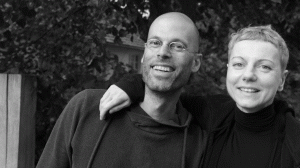#Oldie but Goldie
This article was originally published in November 2018
Early in my career, a good mix of challenge, promise, and a dose of flattery (plus a nice company car) would be enough to draw me into a position. A position I would then enjoy much less than I had imagined.
Twenty years on, I have become much more strategic in looking at what really matters in a workplace. For me, that is, its purpose, the people around me, and my potential to grow. Today: I could not be happier at work. So here comes a Work Choice Canvas — a canvas with the essence of what a great job is all about. At least to me. I’ve used it in mentoring, refined it, and time has come to share it.
 Work Choice Canvas — Overview (icons by Freepic from Flaticon)
Work Choice Canvas — Overview (icons by Freepic from Flaticon)
The Work Choice Canvas has five areas: Purpose, Development, Company, Incomes and Consequences. (Many readers will recognize some similarity with Alex Osterwalder’s Business Model Canvas.)
How can you use it? Print out the working version of the canvas, grab a pen and Post Its. You can do a quick assessment in 30 minutes. Or go deeper, take time and read up on the context. Or follow some of the more intuitive methods described below to find out what emerges.
However you do it — these are the five areas to explore:
1) Purpose — whose lives am I working to improve?
- What is the good cause I will be working for?
- What is the outcome for the people I serve / deliver to? What specific contributions will I make to my customers’ life?
- Suppose I could amplify my contribution, how would society change? What is my social impact, the change I want to see, and support, with my work?
On individual level, purpose is a key ingredient to lasting motivation at work. On organizational level, being purpose-driven is a key trait of next:land companies.
Social changemakers take this even further: what is the impact on society we are aiming to make?
The invitation is to explore the purpose of our work: what is the cause to which we will contribute? This can be in society as a whole or for those directly affected by my work / my company’s products.
2) Development — can I both build and extend my strengths?
- Will I be able to do what I do best?
- Will I be able to extend these capabilities even more?
- Who will I be in three years? What skills will I have built, and what next opportunities might arise from that?
I am a strong believer in strengthening strengths and being So Good They Can’t Ignore You. Dan Pink talks about ability to attain mastery as a second key component to lasting motivation at work.
Learning opportunity is an important ingredient of any of my career choices. Jenny Blake beautifully contrasts the concept of High Net Worth with that of High Net Growth. We are most satisfied — and successful — whenever we can build on our strongest capabilities … and, at the same time, extend them.
3) Company — what person do I want to become in the next five years?
- Whom will I be working with? What social matrix am I inviting into my life?
- Will this fit and feed my core values?
- What is the cultural level of the organization I will be working in?
Jim Rohn famously states that we become the average of the five people we spend most time with. He doesn’t say people we like best, he says: people we spend most time with. That’s our colleagues.
What gets me out of bed every morning, is the social field I work in. I feed on the wonderful people I work with! Be it my fellow dwarfs & Giants, or be it the clients I have the privilege to work for. My daily dose of social bliss is a result of luck, yes, but also of choice and design.
It is helpful to also make norms explicit and see where they overlap with personal core values. Jenny Blake, again, has an easy exercise to mine for core values (see Chapter 1 of her book). Once you have done this, it’s worth checking what environment you will meet.
Finally, the type of organization we work in will play an important role in our socialization. But what will be the social imprint we will be getting? What is the paradigm, the concept of man, underlying this organization?
Until a few years ago, I must admit, my understanding of cultural texture was very vague. This shifted when I read Frederic Laloux’s book Reinventing Organizations. I cannot recommend enough to get familiar with Laloux’s concepts. They help to clarify what kind of life you will be leading in a company.
So, what is the organizational context in which I want to spend my life? Content with the classical Command & Control structure? Or is an agile mindset the Minimum Viable Requirement? Or striving to work in a TEALorganization, living purpose, distributed authority and wholeness?

Work Choice Canvas — Working Version (Icons as above.)
4) Incomes — what capital am I building?
- What will be my incomes?
- Which hidden assumptions am I making?
- What could be my follow-on options?
Time to talk about the income side. First, that’s the financial setup. Here is where you reflect money, income structure, benefits, shares, …
Having turned 50 a while ago, I’m finding it unwise to blindly Follow Your Passion.
Here is the place to do the maths and map it with your income requirements / ambitions. And to get clear about assumptions — on market development, future promotions and the like. Any hopes factored into the scenarios? What would be a case gone worse than expected?
Jobs also have non-tangible incomes. These can be: network, visibility, reputation, … what will be contributions to your career capital?
Finally, I value options and flexibility. My job decisions will always include an aspect of what’s next. Could this job lead to a dead-end situation? Or is it likely to create interesting opportunities?
5) Consequences — ready to deal with the decision’s downsides?
- What will be consequences / potential downsides of my decision? (On me, on others). Am I willing to take them?
- Any risks? How can I manage these?
Allow me to briefly digress. Until some years ago, I thought that there must always be a right solution to every problem. I felt like a detective that needs to understand every potential benefit or cost. Clarify every ambiguity. And then, optimize the outcome.
It felt like there was some hypothetical “ideal” solution, and it was up to me to find it. In hindsight, this was a pretty disempowering mental model.
My updated model is: there is no ideal solution we must un-dig. We are free to choose, and decide, even in the face of ambiguity. Yet, with every decision will come a set of consequences. We need to include into the decision whether we are ready to take on these consequences.
This is easier when we, ourselves, are on the losing side of the consequence. I can easily choose to put my job over my daily trumpet playing.
It is harder when that person is someone else. For example, when my daughter will not see me during weekdays, because I travel so much.

What’s going on outside the profile picture. © Tobias Sutter
Preparing to deal with consequences may need an extra dose of honesty. And it needs follow-on decisions. For me, this means having rock solid weekends. And on Monday mornings, I do my best to not leave town before I’ve sent my daughter off to school. Plus, we take evening time to talk on the telephone, read books or go through her maths homework. People I work with know this, and they respect it.
When I mentored others using Work Choice Canvas, some used it to do very quick assessments of their current work situation and potential options. Even 30 minutes can bring lots of clarity.
To create a vision or prepare a more fundamental shift, however, I suggest to take much more time for thinking and sensing.
If you want to invite also your intuitive capacities, and be open for emergence, you can do
- Overnight reflections, eg. write down an issue before going to sleep and see what new perspectives arise after waking up
- Intuitive walks — do an early morning walk and see what catches your attention. See how this resonates

Art of Hosting Companion / laralistens.eu
- Holding the question — place open questions without seeking immediate answers. Then see how the questions evolve or what comes up over the period of a few days
- Imagination exercises — imagine it’s Monday morning and you are driving to your new work. You park the car and enter the office. How does this feel? What comes up?
However you do it, making the implicit explicit is worth your time. Mapping out your choices on the Canvas will help to de-spaghetti-fy your thinking. This will lead to an easier decision.
And, more importantly, a decision you won’t regret.










